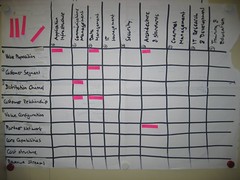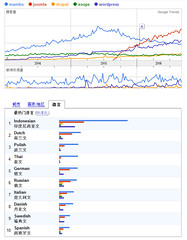Governance Modeling and Success in Content Management
By Matthew Johnson
Technology Director
Razorfish CMS Center of Excellence
http://www.razorfish.com
Over the past 15 years, content management has grown and evolved across organizations. Content Management Systems (CMS) are now shifting from a product driven solution owned by technology departments to a mission critical digital communication system used by marketing and business units to directly execute on initiatives. CMS has grown from document and web management of the late 1990s to a series of tools and processes of today to manage and distribute content across the web via blogs, twitter, social media, web-sites, email, mobile, etc.
Why do Content Management System projects cause so much pain in Enterprise Scenarios?
Large-scale CMS initiatives commonly fail to meet the short and long run expectations of business users. Expectations usually revolve around the establishment of a simple, efficient, powerful, and relevant content management process (or content management framework). This content management process will provide the enterprise with the operational tools to quickly create and deploy professional, high quality, and rich digital content. However, many CMS solutions engender low satisfaction rates due to a discrepancy between what business users want and what they get. A CMS will only deliver the promised business value when attention is paid to the non-technical issues of governance.
What do users want?
Efficient and intuitive ways to quickly add, update, share, re-use, and deploy large quantities of content across various distribution channels. These channels consist of various online B2B, B2C, and B2E properties, which include web sites, micro-sites, widgets, mobile applications, extranets, intranets, blogs, email, and traditional media (e.g. print brochures or direct mail).
What do they get?
An expensive, complicated, often confusing content repository that is perceived to be out-of-date with current trends. The very reasons for adoption of the content management system–decreasing time to market, increasing efficiency, and improving content agility are often the criteria the implementation fails to meet. Many large-scale CMS solutions become rigid, creating operational and technical bottlenecks.
Governance is the Foundation of Successful Content Management
Why do most organization fail to get what they want out of a CMS? A majority of CMS initiatives are executed without proper governance models being established prior to product selection. A majority of CMS initiatives prematurely dive straight into technical design and development, with the project leads hoping that the CMS software product’s features and capabilities will solve operational requirements. More often than not, internal organizational pressure to deliver on time and to limit political discussions on content ownership, accountability, process, and cross-departmental collaboration cause governance model definition activities to be shortened or skipped.
In my experience across many Fortune 100-500 organizations, either external technical consultants or internal technology departments have defined and driven CMS initiatives. Technology consultants seem to be the logical choice and are selected for their subject matter expertise and proven experience with delivering various product driven CMS solutions. These subject matter experts quickly conduct interviews, assessments, requirements, and detailed designs over a typical project duration of 6-12 months. In theory, these tasks are used to identify the strategic short- and long-term content management needs of the organization. However, most of the time, these consultants are placed into situations where the client organization has limited or no expertise in operations management of large-scale cross-channel content repositories. Business users and leadership typically do not have professional backgrounds in periodicals, journals, magazines, and newspapers. These content-based industries are accustomed to the requirements and demands of effectively managing content assets, and have gained experience with the fundamentals of content management governance.
But most organizations are new to content management. They do not have specific departments, roles, goals, and metrics directly tied to content production, oversight, and publishing. This situation creates a significant gap for CMS design and implementation projects, since the core problem is a missing set of processes, operational guidelines, and skill sets, not just the need for a good tool. Technology consultants are typically skilled in information and software architecture of various CMS platforms, but not in operations modeling and governance. This results in a solution being designed from a primarily technical point of view and not specifically designed to meet the needs of a business user and their operational environment.
A governance model is essential for enterprise-wide content management initiatives that cross organizational boundaries and involve large numbers of employees and projects. Successful content management solutions are driven by governance–that is, by people working together—not by technology. Operational problems emerge from failures in day-to-day decisions about how content will be managed, as well as unclear assignment of roles and responsibilities. The decentralized nature of many enterprise content management systems often leads to lack of clear ownership, inconsistencies in use, duplication of efforts, and strong dependencies on technical resources.
What are the benefits of a strong governance model for content management? Strong governance provides an operational and content centric foundation that facilitates growth, increases quality, and improves collaboration across organizational boundaries. The end result is content that is more customer/user centric, better managed and maintained. The sections below break down various strategic and significant areas that are affected by governance. Each section explains the current state on many organizations and their problems, followed by a summary of a future state that can be achieved once a governance model has been established.
Benefits of Governance and CMS
The sections below break down various strategic and significantbusiness areas that are affected by governance. Each section explains the current state on many organizations and their problems, followed by a breakdown of a future state once a governance model has been established.
Governance and Strategic Alignment
Current State
- No clear alignment of the organization’s various content owners with brand’s strategic direction
- No set governance body to administer content and terms of use across channels
- Low awareness of content inventory by other departments (Marketing, Public Relations, Finance, Accounting, Digital Agencies, Advertising Agencies)
Future State
- Clearly defined objectives and alignment with strategic directions and goals of the organization and brand
- Clear governance structure, roles and responsibilities regarding content management
- Clear ownership and accountability for various content assets
Content Creation and Editing
Current State
- Ad hoc and unstructured – leading to duplicate content, inaccurate, out-of-date, or conflicting content
- Technology, vendor, or product specific processes that may not be adopted by the business users at all – because real-life work environments, workflows, resource allocations/skillsets and training needs have not been taken into account
Future State
- In-depth planning and scoping
- Standardized yet customized processes and workflows across the organization and external vendors
- Faster time-to-market of relevant and fresh content
Content Quality and Compliance
Current State
- Technology-driven structure of content directories, taxonomies, metadata, content types, and authoring interfaces
- Inconsistencies in content across channels and organizational units
- Inconsistencies in terms of use and presentation of content across channels
- Content that does not communicate current branding or align with messaging
- Duplication of content and efforts across the organization
- Noncompliance of content with organization guidelines
Future State
- User-friendly and business-driven content type definitions, taxonomies, and metadata that can be shared and re-used across business units, for greater adoption
- Content alignment with segmentation, brand, and organizational messaging
- Greater consistencies in use of content across channel
- Consolidated, streamlined, and up to date content
- Delivery of a more a consistent user experience
- Compliance with organization standards (such as legal requirements, messaging, branding, accessibility)
Organizational Awareness
Current State
- Lack of awareness of content life-cycle process
- No proper process for creating and updating content
- Lack of awareness of responsibilities and requirement for maintaining content
- Lack of promotional calendar/ lack of awareness regarding how to market and promote content to targeted channels, customers, partners, and other departments
Future State
- Ongoing communication and collaboration among business units, partners, and other organizational departments
- Ongoing communication and liaising with agencies on roles and responsibilities
- Higher quality online and offline content distribution channels via structured and operationally efficient content management
Building a governance model
Goal Setting
Once an organization has identified developed a general content management strategy and vision, it’s imperative to then define a set of specific that address governance needs. These goals typically include the following:
- Create a process that improves time-to-market of new and existing content
- Create a formal decision-making process that is accountable, strategic, rational, balanced, and consistent
- Provide the organization with a framework to identify, prioritize and manage content modifications and enhancements
- Establishes a vehicle for communication regarding content management up, down and across the organization
- Enable the sharing of content and resources across the organization
- Create an organizational body that can oversee “shared-cost” investments and avoid duplicative work
It is important that these goals are communicated and aligned to business needs. Executive sponsors must clearly dictate their definition of a goal and their expectations from each department to properly align objectives across organizational boundaries. In enterprise situations, where different organizational units have vastly different priorities, objectives, and performance measures, it is essential that a clearly defined goal be presented to all stakeholders.
For example, the needs and wants of technology and business units can be in direct conflict. Technology departments often focus their goals around centrally-controlled solutions that maximize return on investment and closely align with specific architecture and resourcing guidelines that were establish months to years before a CMS project was initiated. The systems and processes that technology groups deem acceptable may be in direct conflict with the operational needs of business units. Once a common set of goals are agreed upon in definition and scope, the cross-organizational units will be on common ground to participate in the design and development of a governance model that supports content management.
Governance Structures
When it comes to governance, there are many of operational/reporting structures that an organization can adopt. These can include:
1. Hierarchical
Hierarchical Structure is based on the concepts of division of labor, specialization, and unity of command. In the context of CMS, key content decisions and approvals are made at the top and filter down through the organization. Middle content managers, writers or content contributors do the primary production and deployment of content to various channels. Continue reading →

![Reblog this post [with Zemanta]](http://img.zemanta.com/reblog_e.png?x-id=bb648627-6ae9-4108-bd88-fd9ee4a80e51)
![Reblog this post [with Zemanta]](http://img.zemanta.com/reblog_e.png?x-id=c29e9705-d116-4ed4-8f41-4f6553ffb94d)

![Reblog this post [with Zemanta]](http://img.zemanta.com/reblog_e.png?x-id=35932f53-9e3e-42c5-96e9-598b97ab2767)